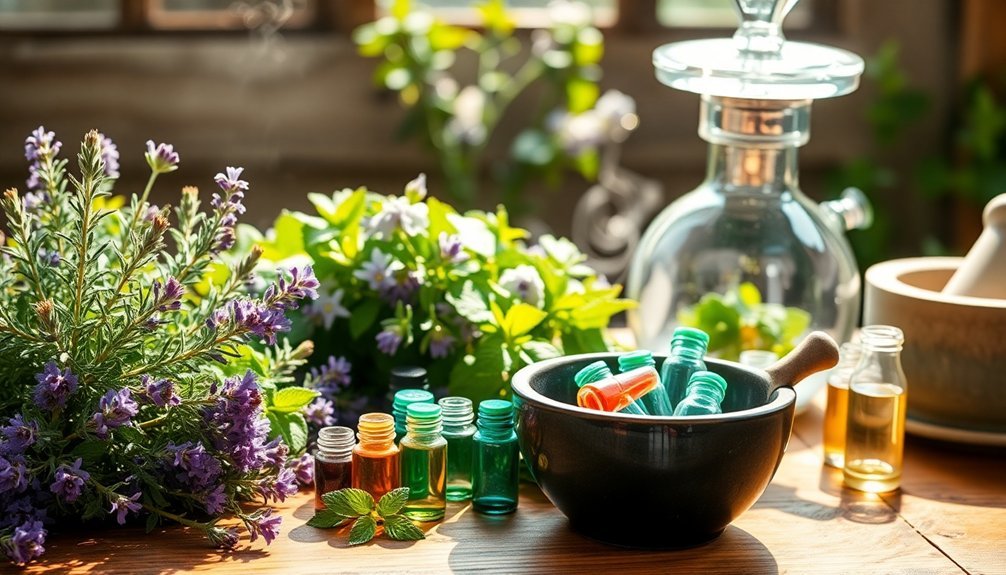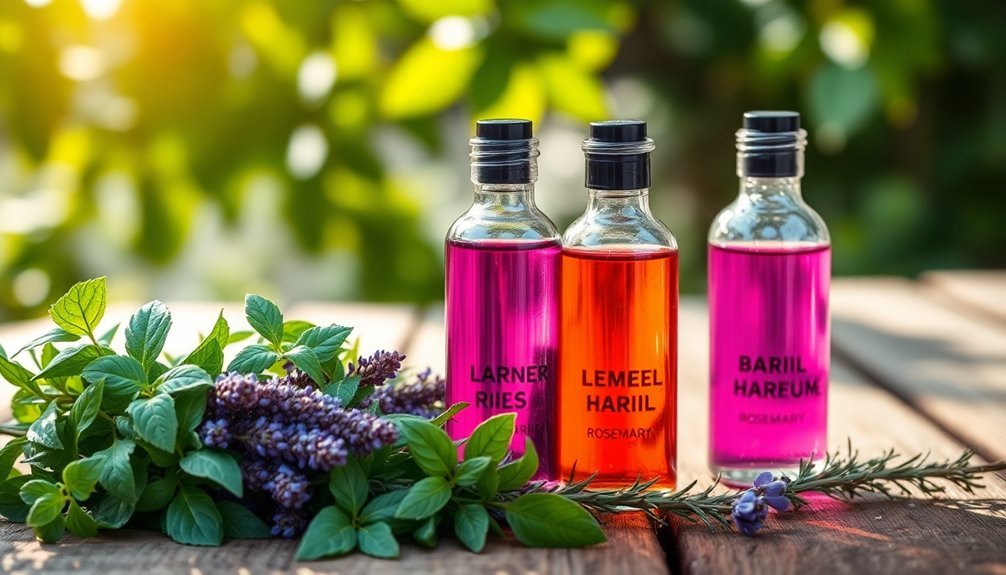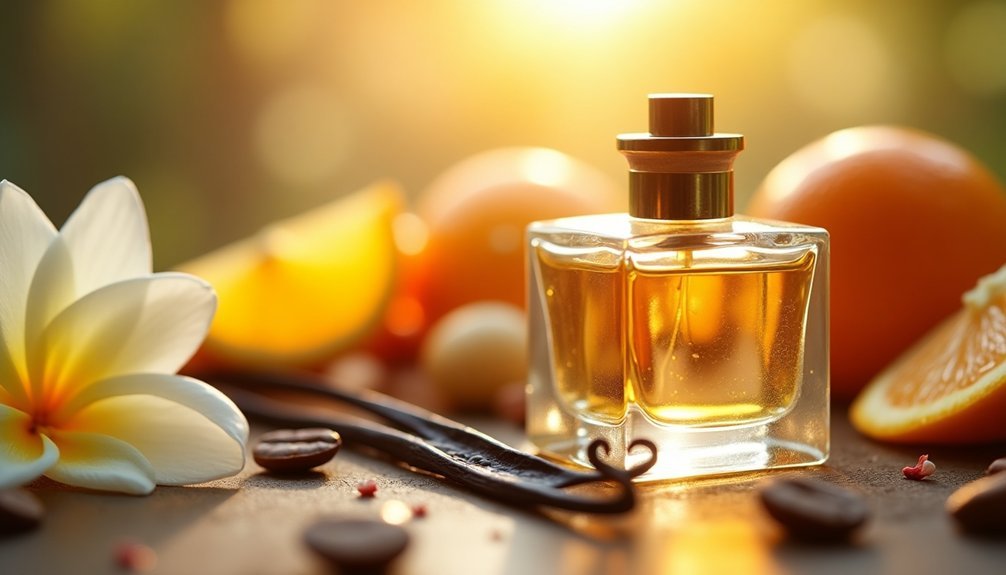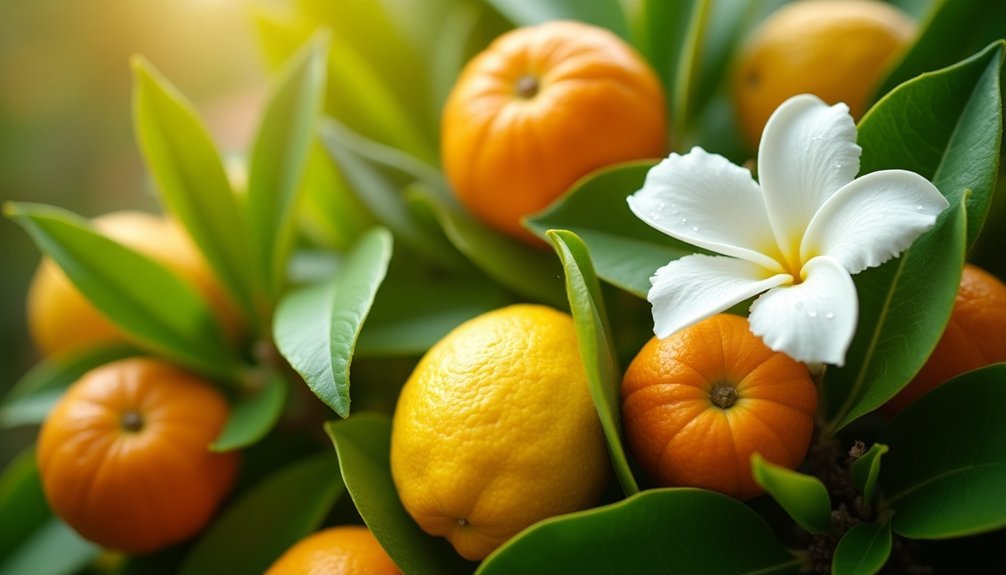You can create natural perfumes at home by steam distilling fragrant herbs from your garden like lavender, mint, and rosemary. Harvest herbs in the early morning when their oils are most concentrated, then gently steam them to extract their aromatic compounds. You'll need basic tools like glass bottles, measuring cups, and a simple distillation setup. By layering different herb combinations and properly storing your creations, you'll discover endless possibilities for crafting unique signature scents.
Essential Tools and Materials for Herbal Perfume Making

Three essential categories of tools are required to create natural perfumes from garden herbs: measuring equipment, extraction devices, and storage containers.
You'll need precise measuring tools like stainless steel cups, spoons, and graduated cylinders to guarantee accurate proportions.
For extraction, gather borosilicate beakers, separatory funnels with metal stands, and a potato ricer for straining botanicals. Don't forget filter papers and droppers for handling essential oils. A UV light sterilizer is essential for sanitizing your equipment before each use.
Store your creations in glass bottles with tight-fitting caps, and use stainless steel bowls and trays for mixing and pouring.
You'll also want an offset spatula for enfleurage and wax carving tools for thick aromatics. Keep grain alcohol or non-GMO spiced rum on hand for preservation, and use a conductivity meter to monitor solution concentrations.
Label everything clearly with self-adhesive papers for proper identification.
Selecting and Preparing Garden Herbs for Distillation
Successful herbal perfume distillation begins with choosing the right plants and preparing them properly.
You'll want to select herbs with strong, distinct fragrances like lavender, mint, and rosemary, along with floral notes from sweet pea or marigold. Your fragrance will develop in three distinct layers as the herbs release their aromas. Consider adding citrus elements with lemon balm or calming notes from chamomile.
Harvest your herbs at dawn when their essential oils are most concentrated. Let them wither slightly to reduce moisture, then carefully break or cut them to release their aromatic compounds.
If you're using dried herbs, remove the stems for better infusion. Always opt for organic plants to avoid pesticide residue, and store your harvested herbs in a cool, dry place until you're ready to distill.
Keep any water-based extracts refrigerated to maintain their potency.
Step-by-Step Steam Distillation Process

Once you've gathered and prepared your herbs, the steam distillation process will transform them into concentrated aromatic oils. Add water to your boiler and heat it until it reaches 212°F. Place your crushed herbs in the still chamber, where rising steam will extract their aromatic compounds. Maintaining proper cooling temperatures between 4-10°C in the condensing pipes is crucial for complete liquefaction.
| Stage | Action | Result |
|---|---|---|
| Initial | Steam passes through herbs | Aromatic compounds vaporize |
| Middle | Vapor flows to condenser | Steam cools and liquefies |
| Final | Liquid enters separator | Oil separates from hydrosol |
As the vapor cools in the condenser, it'll form two distinct products: essential oil and floral water (hydrosol). You'll collect both in separate vessels, with the oil floating above the hydrosol. This gentle extraction method preserves your herbs' delicate compounds while producing pure, concentrated oils within about an hour.
Creating Layered Scents With Different Herbs
Creating layered scents with herbs allows you to craft complex, personalized perfumes that evolve throughout the day. Start with a strong base note like rosemary for its woody depth, then add middle notes of lavender or chamomile for warmth. Finally, top your blend with invigorating mint or bright lemon balm to achieve an uplifting finish.
- Layer your fragrances from strongest to lightest, applying a moisturizer first to help the scents adhere better to your skin.
- Combine herbs from the same scent family initially, such as floral with floral, before experimenting with contrasting aromas.
- Use both fresh garden herbs and essential oils in your blends to achieve the perfect balance of natural complexity and staying power.
Storing and Preserving Your Natural Perfumes

Proper storage practices can dramatically extend the life of your natural perfumes and preserve their delicate aromatic profiles. Since your garden-derived fragrances don't contain synthetic preservatives, they'll need extra care to maintain their quality. Keep your bottles in a cool, dark cabinet away from your bathroom, as humidity and temperature changes can quickly degrade natural ingredients.
| Storage Factor | Do's | Don'ts |
|---|---|---|
| Location | Cool, dark cabinet | Windowsills, bathroom |
| Temperature | Stable, room temp | Near heat sources |
| Container | Dark glass, tight seal | Clear bottles, loose caps |
| Position | Store upright | Lay bottles down |
| Usage | Small bottles | Large containers |
Always seal bottles tightly after each use and consider creating smaller batches, as natural perfumes typically last 1-2 years once opened. Test your perfume's quality by spraying it in the air before applying to skin.
Frequently Asked Questions
Can I Use Citrus Peels Along With Herbs in the Same Distillation?
Yes, you can distill citrus peels with herbs together. You'll need to be careful about pairing complementary scents and monitoring distillation times, as different botanicals may require varying extraction periods for ideal results.
How Do I Test for Allergic Reactions to Homemade Herbal Perfumes?
You'll need to patch test your perfume on a small area of inner arm. Apply a diluted amount and monitor for reactions over 48 hours. If there's no irritation, try a full application.
Why Do Some Herbs Produce Less Essential Oil Than Others?
You'll find that some herbs produce less oil due to their genetic makeup, growing conditions, and maturity level. Plant species naturally vary in their oil-producing glands and environmental stress responses.
Is It Possible to Recreate Commercial Perfume Scents Using Garden Herbs?
You can't exactly replicate commercial perfumes using garden herbs since they often contain synthetic molecules. However, you're able to create unique, natural fragrances that may share similar scent profiles with commercial perfumes.
What Causes Cloudiness in My Distilled Perfume, and How Can I Prevent It?
Your perfume's cloudiness is likely due to water content, insoluble oils, or improper mixing. You'll prevent this by using high-purity alcohol, adding solubilizers, and carefully balancing the ratio of oils to alcohol.
In Summary
You've learned the basics of creating your own natural perfumes from garden herbs. With the right tools and careful distillation, you'll be able to capture nature's fragrances in your own signature scents. Remember to experiment with different herb combinations and proper storage techniques. Don't be afraid to try new blends – that's how you'll discover your perfect natural perfume. Keep practicing, and you'll master this rewarding craft.





Leave a Reply